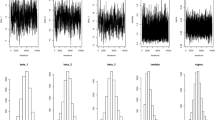Abstract
The over all regression function in a semi-parametric model involves a partly specified regression function in some primary covariates and a non-parametric function in some other secondary covariates. This type of semi-parametric models in a longitudinal setup has recently been discussed extensively both for repeated Poisson and negative binomial count data. However, when it is appropriate to interpret the longitudinal binary responses through a binary dynamic logits model, the inferences for semi-parametric Poisson and negative binomial models cannot be applied to such binary models as these models unlike the count data models produce recursive means and variances containing the dynamic dependence or correlation parameters. In this paper, we consider a general multinomial dynamic logits model in a semi-parametric setup first to analyze nominal categorical data in a semi-parametric longitudinal setup, and then modify this model to analyze ordinal categorical data. The ordinal responses are fitted by using a cumulative semi-parametric multinomial dynamic logits model. For the benefits of practitioners, a step by step estimation approach is developed for the non-parametric function, and for both regression and dynamic dependence parameters. In summary, a kernel-based semi-parametric weighted likelihood approach is used for the estimation of the non-parametric function. This weighted likelihood estimate for the non-parametric function is shown to be consistent. The regression and dynamic dependence parameters of the model are estimated by maximizing an approximate semi-parametric likelihood function for the parameters, which is constructed by replacing the non-parametric function with its consistent estimate. Asymptotic properties including the proofs for the consistency of the likelihood estimators of the regression and dynamic dependence parameters are discussed.
Similar content being viewed by others
References
Agresti A. and Natarajan R. 2001 Modeling clustered ordered categorical data: A survey. International Statistical Review, 69, 345–371.
Amemiya T. 1985 Advanced Econometrics. Cambridge, MA: Harvard University Press.
Altman N. S. 1990 Kernel smoothing of data with correlated errors. J. Amer. Statist. Assoc., 85, 749–758.
Chen J., Li D., Liang H. and Wang S. 2015 Semiparametric GEE analysis in partial linear single-index models for longitudinal data. Ann. Statist., 43, 1682–1715.
Ekholm A., Jokinen J. and Kilpi T. 2002 Combining regression and association modelling for longitudinal data on bacterial carriage. Stat. Med., 21, 773–791.
Ekholm A., Jokinen J., McDonald J.W. and Smith P.W.F. 2003 Joint regression and association modelling for longitudinal ordinal data. Biometrics, 59, 795–803.
Jokinen J. 2006 Fast estimation algorithm for likelihood-based analysis of repeated categorical responses. Computational Statistics and Data Analysis, 51, 1509–1522.
Kaufmann H. 1987 Regression models for nonstationary categorical time series: Asymptotic estimation theory. Ann. Statist., 15, 79–98.
Lin X. and Carroll R. J. 2001 Semiparametric regression for clustered data using generalized estimating equations. J. Am. Statist. Ass., 96, 1045–1056.
Lipsitz S. R., Laird N. M. and Harrington D. P. 1991 Generalized estimating equations for correlated binary data: Using the odds ratio as a measure of association. Biometrika, 78, 53–160.
Lipsitz S. R., Kim K. and Zhao L. 1994 Analysis of repeated categorical data using generalized estimating equations. Stat. Med., 13, 1149–1163.
McDonald D. R. 2005 The local limit theorem: A historical perspective. Journal of Iranian Statistical Society, 4, 73–86.
Pagan A. and Ullah A. 1999 Nonparametric Econometrics, Cambridge: Cambridge University Press.
Severini T. A. and Staniswallis J. G. 1994 Quasi-likelihood estimation in semi-parametric models. Journal of American Statistical Association, 89, 501–511.
Sneddon G. and Sutradhar B.C. 2004 On semiparametric familial-longitudinal models. Statistics and Probability Letters, 69, 369–379.
Sutradhar B. C. 2003 An overview on regression models for discrete longitudinal responses. Statist. Sci., 18, 377–393.
Sutradhar B.C. 2011 Dynamic Mixed Models for Familial Longitudinal Data. Springer, New York.
Sutradhar B.C. 2014 Longitudinal Categorical Data Analysis. Springer, New York.
Sutradhar B. C. and Dasgupta N. 2016 Dynamic models for longitudinal ordinal non-stationary categorical data. In: Lecture Notes in Statistics, Springer, Switzerland, 218, 169–197, B. C. Sutradhar (Editor).
Sutradhar B. C. and Kovacevic M. 2000 Analyzing ordinal longitudinal survey data: Generalized estimating equations approach. Biomerika, 87, 837–848.
Sutradhar B. C., Warriyar K. V. and Zheng N. 2016a Inferences in semi-parametric dynamic models for repeated count data. Australian and New Zealand Journal of Statistics, 58, 397–434.
Sutradhar B. C., Jowaheer V. and Rao R. P. 2016b Semi-parametric models for negative binomial panel data. Sankhya A: The Indian Journal of Statistics, 78, 269–303.
Warriyar K. V. V. and Sutradhar B. C. 2014 Estimation with improved efficiency in semi-parametric linear longitudinal models. Brazilian Journal of Probability and Statistics, 28, 561–586.
Wedderburn R.W.M. 1974 Quasi-likelihood functions, generalized linear models, and the Gauss-Newton method. Biometrika, 61, 439–447.
Williamson J. M., Kim K. and Lipsitz S. R. 1995 Analyzing bivariate ordinal data using a global odds ratio. Journal of American Statistical Association, 90, 1432–1437.
Yi G. Y. and Cook R. 2002 Marginal methods for incomplete longitudinal data arising in clusters. J. Amer. Statist. Assoc., 97, 1071–1080.
Zeger S. L. and Diggle P. J. 1994 Semi-parametric Models for Longitudinal Data With Application to CD4 Cell Numbers in HIV Seroconverters, Biometrics, 50, 689–699.
Zheng N. and Sutradhar B. C. 2016 Inferences in dynamic logits models in semi-parametric setup for repeated binary data. Submitted.
Acknowledgements
The author thanks the referee for constructive comments and suggestions leading to the improvement of the paper. This research was supported partially by a grant from Natural Sciences and the Engineering Research Council of Canada.
Author information
Authors and Affiliations
Corresponding author
Rights and permissions
About this article
Cite this article
Sutradhar, B.C. Semi-parametric Dynamic Models for Longitudinal Ordinal Categorical Data. Sankhya A 80, 80–109 (2018). https://doi.org/10.1007/s13171-017-0100-z
Received:
Published:
Issue Date:
DOI: https://doi.org/10.1007/s13171-017-0100-z
Keywords and phrases
- Binary mapping for cumulative multinomial responses
- Consistency
- Dynamic logits model for repeated nominal multinomial responses
- Kernel-based weighted likelihood
- Lag 1 transitional probabilities for cumulative responses
- Non-parametric function in secondary covariates
- Ordinal categories
- Parametric linear predictor in primary covariates
- Semi-parametric models and likelihood estimation.



